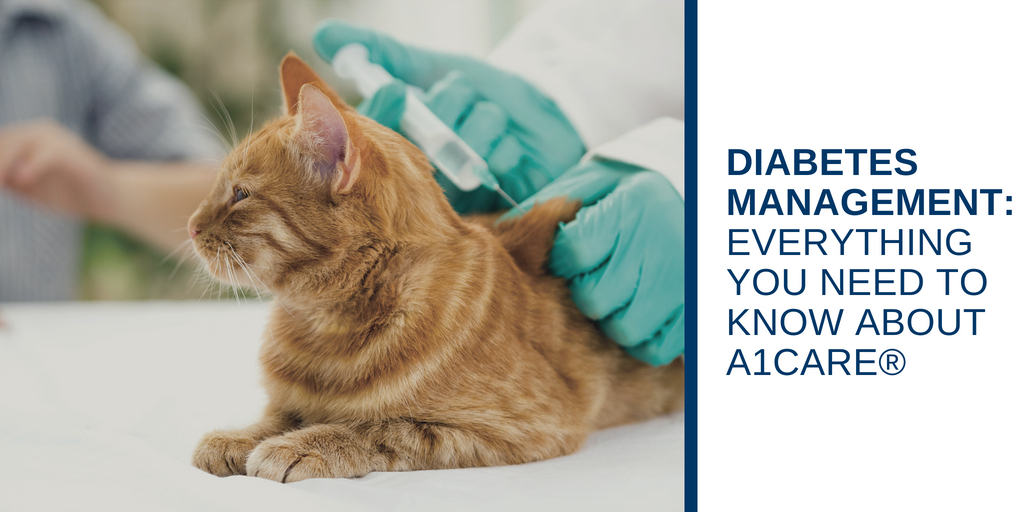
Diabetes Management: Everything You Need to Know About A1Care®
(Editor’s note: All content provided by Baycom Diagnostics. For more information, please ask your Patterson Veterinary rep or visit baycomdiagnostics.com.)
The prevalence of diabetes mellitus in dogs increased from 13.1 cases per 10,000 in 2006 to 23.6 cases per 10,000 in 2015 – a 79.7 percent increase. The prevalence of diabetes mellitus in cats increased from 57.2 cases per 10,000 in 2006 to 67.6 cases per 10,000 in 2015. Although this represents only an 18.1 percent increase, diabetes mellitus is nearly three times more common in cats than in dogs.
Baycom Diagnostics has developed a simple, economical, veterinary mail-in A1c (glycated hemoglobin) test for diagnosing and monitoring canine and feline diabetes. With a few drops of dried blood, A1Care® determines the average blood glucose levels for the previous 70 days in cats and 110 days in dogs.
Measurements
A1c measures glycated hemoglobin. Glucose binds to hemoglobin in red blood cells at a steady rate over the lifespan of the cells, giving an accurate average level of glucose present over time. The higher the glucose concentration, the higher the level of A1c. Levels of A1c are not affected by daily fluctuations in blood glucose concentrations caused by medications, exercise, diet or amount of insulin present in the blood. Because it measures the average concentration of blood glucose over an extended period, it is not affected by stress hyperglycemia.
The attraction of the simple biochemical concept combined with a clinical requirement for a long-term market of glycolic control in diabetes has made hemoglobin (A1c) one of the most important assays undertaken in the medical laboratory. It has been long endorsed by the American Diabetes Association and the Endocrine Society and is used, along with blood glucose monitoring, to achieve optimum diabetic control in humans. Glucose testing by itself has several deficiencies including an inconvnient requirement for fasting, sample instability (glucose concentrations undergo 5-7% reduction per hour in test tubes), significant differences in biological variability among individuals, different modes of testing (plasma, whole blood or serum), and inability to detect stress-related hyperglycemia. Fructosamine testing measures glycosylated proteins in plasma (mostly albumin). Albumin degrades faster than hemoglobin, yields a narrower window of previous glucose concentration (7-14 days) with a wider range of results, even in the presence of experimentall controlled hyperglycemia. In humans, the considerable overlap between diabetics and non-diabetics limits its usefulness, and it is not a suitable screening test for the disease. Cats with recent onset of diabetes (<1-2 weeks) or cats with mild diabetes may have normal fructosamine levels. Diabetic cats with concurrent hyperthyroidism or hypoproteinemia may have normal fructosamine levels.
The Value of A1c
The value of A1c testing in humans was recognized since the 1960s. However, the creation of functional assays took years to develop. Doctors and patients, and likewise veterinarians, require a test that is reliable, interpretable, and convenient. More than any other analyte, A1c is a longitudinal parameter: results of a patient are monitored over years and may form the basis for change in therapy. This requires highly reproducible results over a long period of time. Additionally, testing must be efficient, economical and robust. Successful development of methodologies satisfied this requirement for humans, and now, the same is true for veterinarians. All human A1C tests comply with the National Glycohemoglobin Standardization Program (NGSP.org), which assures quality controls for all tests. Baycom Diagnostics follows those guidelines with A1Care®. No national standardization exists for glucose or fructosamine testing.
Clinical Assessment Trial for A1Care
Summary: Three Tallahassee-based veterinary hospitals submitted a total of 77 dried blood samples and concurrent glucose data from diabetic and nondiabetic dogs and cats over a period of 8 weeks in the fall of 2016. Over 300 tests including A1c with A1Care®, comparative high performance affinity liquid chromatography (HPALC) and mass spectrometry were performed by the Florida State University Hybridoma Laboratory. Appropriate feline and canine controls developed using NGSP-certified methodology were used, along with human NGSP-certified A1c controls. All controls were verified. All samples were tested when delivered and retested 2-3 weeks later. More than 50% of the A1C results were verified using mass spectrometry, and approximately 30% of the samples were tested using HPALC methodology. In all tests, the coefficient of variation (CV) was ≤ 5%. Additionally, all samples were compared to blood glucose measurements taken at the time of sampling. Total canine samples correlated well with blood glucose levels while the feline sample did not. The variation in the feline samples correlation is assumed to reflect stress hyperglycemia.

Conclusion: A1Care® is a valid A1c test for determination of average blood glucose concentration for the previous 70 days in cats and 110 days in dogs. The coefficient of variation (CV) remained ≤ 5% between samples tested at the time of delivery and again three weeks later. Additionally, the test was validated against human and canine/feline controls. As with A1C testing in humans, the creation of a verified veterinary test that yields more complete blood glucose information practically, conveniently and economically paves the way for better diabetes detection and monitoring for the steadily increasing number of dogs and cats affected by this disease.
References
1. Banfield Pet Hospital. Section One: Diabetes Mellitus. In: State of Health® 2016 Report. 2016:12-13.
2. Weycamp C, John WG, Mosca A. A review of the challenge of measuring hemoglobin A1c. J Diabetes Sci Technol. 2009 May 1;3(3):439-435.
3. Link K, Rand J. Changes in blood glucose concentration are associated with relatively rapid changes in circulating fructosamine concentrations in cats. J Feline Med Surg. 2008 Dec;10(6):583-592.
4. Mula-Abed WA, Al-Naemi AH. Performance indicators and validity of serum fructosamine assay as a diagnostic test in a screening program for diabetes mellitus. Saudi Med J. 2003 May;24(5):477-484.
5. Reusch C. Feline Diabetes Mellitus. In: Textbook of Veterinary Internal Medicine. 7th ed. St. Louis, MO: Saunders Elsevier; 2010: 1796-1816.
6. American Diabetes Association. Tests of glycemia in diabetes: position statement. Diabetes Care. 1998;21:S69-S71.